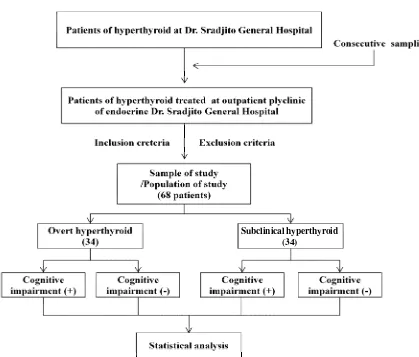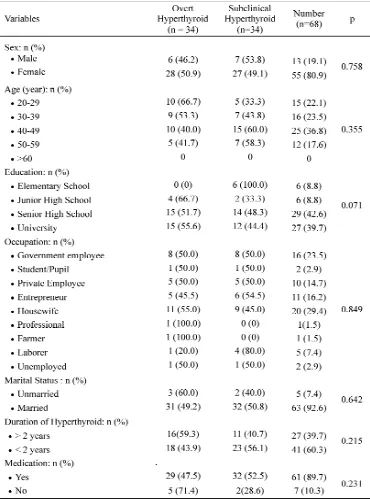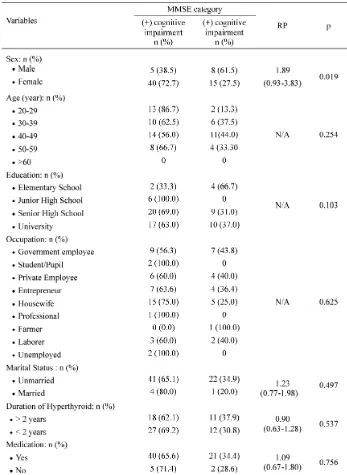* corresponding author: [email protected]
Correlation between overt hyperthyroid
and subclinical hyperthyroid and cognitive
impairment in Dr. Sardjito General
Hospital, Yogyakarta, Indonesia
Berkat Hia1*, Pernodjo Dahlan2, Abdul Ghofir2
1District Hospital of Gunung Sitoli, Nias, North Sumatra, 2Department of Neurology,
Faculty of Medicine, Universitas Gadjah Mada/Dr. Sardjito General Hospital, Yogyakarta, Indonesia
ABSTRACT
Hyperthyroidism is a metabolic imbalance resulting from excessive production of thyroid hormones. Overt or subclinical hyperthyroid prevalence has reached 20%. The differences in thyroid status induce apoptosis in adult cerebral cortex. Triiodothyroxine (T3) acts directly on the cerebral cortex mitochondria and induces the release of cytochrome-c which leads to apoptosis. The increase of hormone levels encountered in hyperthyroidism which is associated with an increase in necrotic death of neurons and oxidative stress has a negative effect on cognition. Several studies demonstrated the significant association of hyperthyroidism with cognitive impairment, despite remaining as controversial results. The study aimed to evaluate the correlation between overt hyperthyroid and subclinical hyperthyroid and cognitive impairment in hyperthyroidism patients. This was a cross-sectional study involving 68 patients of hyperthyroidism who were treated in Endocrine Clinic of Dr. Sardjito General Hospital, Yogyakarta. The inclusion criteria were hyperthyroidism based on anamnesis, clinical examination and laboratory tests, age of 20-60 years, symptoms of hyperthyroidism, and minimum education of elementary school. The relationship of hyperthyroidism and cognitive impairment, and multivariate analysis was analyzed by Chi-square and logistic regression tests, respectively. The results were considered as statistically significant if the value of p was <0.05. The results showed that overt hyperthyroidism had significantly associated with cognitive impairment (p = 0.021). Another variable associated with cognitive impairment was female gender (p = 0.019). In a multivariate analysis, the variables of overt hyperthyroidism (p = 0.024) and sex (p = 0.025) had independent association with cognitive impairment. In conclusion, this study found that overt hyperthyroidism had a significant association with incidence of cognitive impairment compared to subclinical hyperthyroidism.
ABSTRAK
minimal sekolah dasar. Hubungan antara hipertiroid dan gangguan kognitif, dan multivariat dianalisis dengan testChi Squaredan regresi logistik. Hasil analisis dinyatakan bermakna secara statistik apabila nilai p<0.05. Hasil penelitian menunjukkan bahwa hipertiroid secara klinik mempunyai hubungan bermakna dengan gangguan kognitif (p=0,021). Variabel lain yang mempunyai hubungan dengan gangguan kognitif adalah jenis kelamin perempuan (p=0,019). Pada analisis multivariat, hipertiroid klinik (p=0,024) dan jenis kelamin (p=0,025) mempunyai hubungan independen dengan gangguan kognitif. Dari penelitian ini dapat disimpulkan bahwa hipertiroid klinik mempunyai hubungan bermakna dengan gangguan kognitif dibanding dengan hipertiroid subklinik.
Keywords: hyperthyroidism - overt - subclinical - cognitive - mini-mental state examination
INTRODUCTION
Hyperthiroidism is a syndrome resulting from the increased level of free thyroid hormones in the body due to the impairment of some organ systems signified by the increased levels of free thyroxine (fT4 or T4), free triiodothyronine (fT3or T3) and the decrease of thyroid stimulating hormone (TSH).1,2
Hypertiroidism may be caused by some factors. Graves’ disease is the most common cause and an autoimmune impairment related to the antibody. Single or multiple thyroids that produce thyroid hormone may also cause hyperthyroidism. Some studies showed that the changes of thyroid function affect brain metabolism and may cause cognitive impairment at different levels of severity, and even dementia. This involves primary neuro-transmitters of acetylcholine, dopamine, norepinephrine, serotonin, and aminobutyric acid. This alteration involves the axis of pituitary-tiroid hypotalamus resulting in cognitive and affective impairments.3
Subclinical hyperthyroid is more prevalent than overt hyperthyroid which is related with cognitive impairment. Caresini et al.4
demonstrated that among 1453 patients with thyroid function impairment, about 7.8% of them
decrease of MMSE (mini-mental state exami-nation) score. The cognitive impairment resulting from hyperthyroid was 2.26 times higher than eutiroid. Hyperthyroid with the higher levels of T
4is associated with the increased risk of dementia
and Alzeimer diseases.It was showed that the higher level of T
4 was associated with large
amount of plaque neuritic (PN) and neuro fibrillary tangle (NFT) in the cortex (girus frontalis media, inferior parietal lobes, temporal media and occipital cortex).5Singhet
al.6showed that the thyroid status differences
induced apoptosis in adult cerebral cortex, where T3 was expected to play a role directly in the mitochondrial cerebral cortex and induced the release of sitokrom-C to induce apoptosis. In neurogenesis the role of mitochondria is very important for brain development.
MATERIALS AND METHODS
as follow 1) hyperthyroid patients with level of TSH < 0,3 mIU/L; 2) age of 20-60 years; 3) minimum education of elementary school; and 4) consent of participation. The exclusion criteria were patients with history of 1) hypertension; 2) cerebrovascular disease; 3) capitis trauma; 4) diabetes; 5) brain infection; 6) hypothyroid; 7) dislipidemia; 8) smoking; 9) heart disease; 10) malignancy/tumor; 11) parkinson.
The independent variables of the study were age, gender, hyperthyroid type, marital status, history of hyperthyroid medication, occupation, and length of medication. The dependent variable was MMSE category. The association of hyperthyroid category and MMSE was analyzed in two phases: bivariate analysis using Chi square test,and multivariate analysis using logistic regression.
FIGURE 1. The scheme of the study
RESULTS
Sixty eight hyperthyroid patients consisted of 34 overt hyperthyroid patients and 34 subclinical hyperthyroid patients participated in this study. All subjects were taking the medication at the Endocryne Polyclinic of Dr.
Sardjito General Hospital, Yogyakarta. The characteristics of subjects are presented in TABLE 1. There was no significant difference of subjects’ characteristics between overt hyperthyroid and subclinical hyperthyroid patients observed in this study (p > 0.05).
To identify the correlation between other variables and MMSE category (cognitive impairment) bivariate analysis was performed as presented in TABLE 2. Among variables evaluated, the female was significantly associated with cognitive impairment in hyperthyroid patients (RP= 1.891; 95%CI=
0.933-3.832; p=0.019). The female patients with hyperthyroid had the cognitive impairment ration of 1.891 times higher than subclinical hyperthyroid patients. Other variables such as age, education, marital status, duration of hyperthyroid medication were not associated with cognitive impairment.
TABLE 2. Bivariate analysis of the association of other variables and MMSE category
The result of the analysis of hyperthyroid category variable on MMSE category showed statistically significant difference (RP= 1.50; 95% CI= 1.046-2.150; p = 0.021) (TABLE 3).
It was indicated that the patients with overt hyperthyroid had the ratio of cognitive impairment prevalence of 1.50 times higher than the patients of subclinical hyperthyroid.
TABLE 3. Bivariate analysis of the association of hyperthyroid category and MMSE category
Multivariate analysis was performed for the sex category variable and overt hyperthyroid showed that it had significant bivariate association with cognitive impairment (TABLE
4). The results of multivariate analysis suggested that female sex and overt hyperthyroid had independent association with cognitive impairment.
TABLE 4. Multivariate analysis of the association of female sex variable with overt hyperthyroid and cognitive impairment.
DISCUSSION
Among 68 patients of hyperthyroid involved in this study, the percentage of male patients was 19.1% (13 patients) and 80.9% (55 patients) for female patients. The percentage of patients were comparable with some others studies. Vadiveloet al.1involved 2024 patients
in their study consisting 22.6% of male patients and 77.4% of female patients, whereas Aryal
7
(25 patients or 36.8%) with the average age of 41 ± 10.6 years (TABLE 1). The most prevalence based on the age in this study was comparable also with some other studies. Vogel
et al.8 reported that the average age of
subclinical or overt hyperthyroid was 35.2 ± 9.8 years, whereas Canariset al.9showed that
was 11.6±5.36 years for overt hyperthyroid and 7.8 ±3.56 years for subclinical hyperthyroid.
Regarding to the occupation, 20 (29.4%) were housewives. This finding was in accordance with the Indonesian demography as reported by the National Statistic Bureau (BPS) in 2004 that there was 52.7% of married women in rural and 63.3% in urban areas.10Concerning
the marital status, 63 (92.6%) were married. This proportion is in line with the National Report of Basic Health Research (RIKESDAS) in 2010 which suggested that in the productive age of 15-49 years in Indonesia, 50.4% were married.11 About the category of length of
hyperthyroid, the number of those who had been suffering from hyperthyroid of more than 2 years was 39.7% and those with less than 2 years of hyperthyroid was 60.3%. Meanwhile 89.7% had had treatment since the recognition of hyperthyroid.
The variable-associated cognitive impairment was hyperthyroid category with the RP of 1.500 (95%CI = 1.046-2.150; p = 0.021). Meanwhile for female the RP was 1.891 (95% CI= 0.933-3.832; p = 0,019). This result showed that female patients of hyperthyroid and overt hyperthyroid had the risk of cognitive impairment of 1.5 and 1.891 respectively, higher than male patients and subclinical hyperthyroid. Hyperthyroid is characterized by high fT4and low TSH and can arouse oxidative stress with the negative effect on cognition.12
Van Oschet al.13suggested that hyperthyroid
with low level of TSH results in neuron damage could lead to the decreased secretion of TRH or decreased response from pituitary. TSH and TRH were analogues with the increased synthesis of acetylcholine in rats, while the increased level of hormones found in hyperthyroid was associated with the increase of necrotic neuron death and oxidative stress.13
Braathen et al.14 found thatPoly Chlorinated
Biphenyls (PCBs) had effect on five variables of thyroid hormones of TT4, fT4, TT3, fT3, TT4:TT3in women but in men only affected two variables of fT4 and fT3. This higher exposure had resulted in the difference between women and men. The difference affects cognitive impairment based on gender.14 It has been
reported that female production hormone on immunology was also affected by the low androgen hormone that might protect autoimmune disease in hyperthyroid patients.15
The result of multivariate analysis suggested that the variable of overt hyperthyroid is associated independently with cognitive impairment. Hogervorst et al.12in their study
found that the risk of cognitive impairment in overt hyperthyroid patients were twice higher than those with subclinical hyperthyroid after the follow up of 2 years. Similar finding was also reported by Ceresini et al.4 which stated
that a negative correlation between hyperthyroid and cognitive impairment was twice higher than eutiroid. This risk was due to the increased level of thyroid hormone with the effect on neuron damage and because it destroyed the release of acetylcholine. The increase of thyroid hormone level will increase oxidative stress that leads to apoptosis that can damage or even cause the death of neuron.4
The cross sectional method with once risk factor measurement in this study had made it difficult to measure natural discourse of the disease. Cohort study is a better method to identify the causal relationship between risk factors and the commorbidity.16 In this study,
CONCLUSION
The study demonstrates that patients with overt hyperthyroid have more significant association with cognitive impairment than with patients with subclinical hyperthyroid.
ACKNOWLEDGEMENTS
Authors would like to thank all subjects who participated in this study. We also thank the Head of Endocryne Polyclinic of Dr. Sardjito General Hospital, Yogyakarta who has provided permission and facilities during this study.
REFERENCES
1. Vadiveloo T, Donnan PT, Cochrane L, Leese G. The Thyroid Epidemiology, Audit, and Research Study (TEARS): The natural history of endogenous subclinical hyperthyroidism. J Clin Endocrinol Metab 2010; 96(1):E1–8.
2. Schraga ED. Hyperthyroidism, thyroid storm, and graves disease. [serial online] 2010 Available from: http://emedicine.medscape.com/article/ 767130-overview
3. Maugeri D, Motta M, Salerno G, Rosso D, Hiazarella R, Salomone MS.et al.Cognitive and affective disorder in hyperthyroid and hypothyroid elderly patients. Catania: Hospital Via Messina, 1998.
4. Ceresini G, Lauretani F, Maggio M, Ceda GP, Morganti S, Usberti E, et al. Thyroid function abnormalities and cognitive impairment in the elderly. J Am Geriatr Soc 2009;57(1): 89–93. 5. Jong FDJ, Masaki K, Chen H, Remaley AT,
Monique MBB, Helen P, et al.Thyroid function, the risk of dementia and neuropathologic changes: The Honolulu Asia aging study. Neurobiol Aging 2007;30: 600–6.
6. Singh R, Upadhyay G, Godbole MM. Hypothyroidism alters mitochondrial morphology and induces release of apoptogenic proteins during rat cerebellar development. J Endocrinol 2003;176:321–9.
7. Aryal M, Gyawali P, Rajbhandari N, Aryal P, Pandeya DR. A prevalence of thyroid dysfunction in Kathmandu University Hospital. Nepal Biomed Res 2010; 21(4): 411-5.
8. Vogel A, Elberling TV, Hording M, Dock J, Waldemar G. Affective symptoms and cognitive functions in the acute phase of Graves’ thyrotoxicosis. Psychoneuroendocrinology 2007;32: 36–43.
9. Canaris GJ, Manowitz NR, Mayor G, Ridgway EC. The Colorado thyroid disease Prevalence study. Arch Intern Med 2000;160:526-534.
10. Anonim. Status ibu rumah tangga. Jakarta: Badan Pusat Statistik (BPS) Nasional, 2004.
11. Anonim. Laporan nasional riset kesehatan dasar (RISKESDA). Jakarta: Departemen Kesehatan RI, 2010.
12. Hogervorst E, Huppert F, Matthews FE, Brayne C. Thyroid function and cognitive decline in the MRC cognitive function and ageing study. Psychoneuroendocrinology 2008;33(7):1013-22.
13. van Osch LA, Hogervorst E, Combrinck M, Smith AD. Low thyroid-stimulating hormone as an independent risk factor for Alzheimer disease. Neurology 2004;62:1967–71.
14. Braathen M, Derocher AE, Wiig O, Sørmo EG, Lie E, Skaare JU,et al.Relationships between PCBs and Thyroid Hormones and Retinol in Female and Male Polar Bears. Environ Health Perspect 2004;112(8):826-33.



